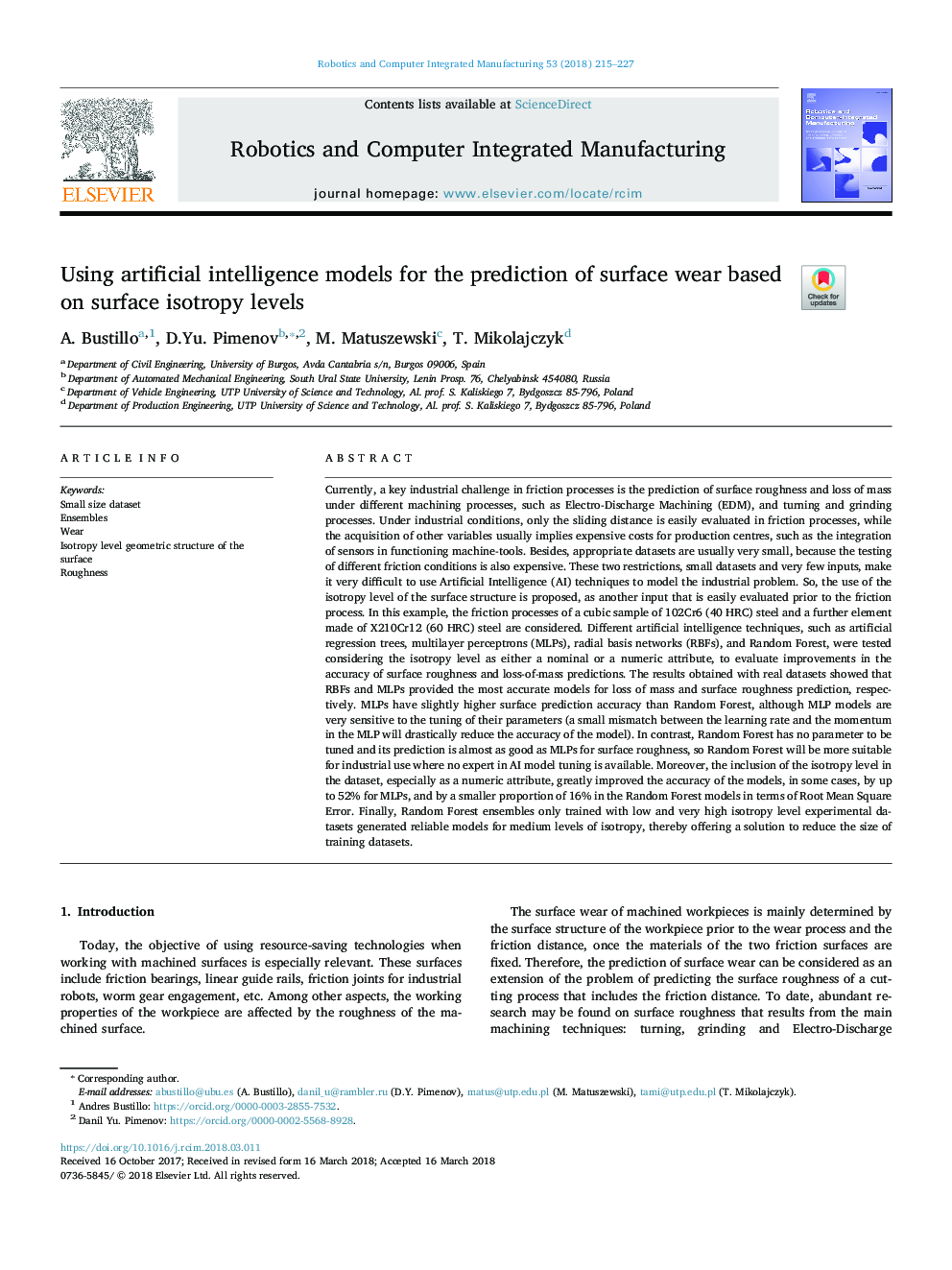| کد مقاله | کد نشریه | سال انتشار | مقاله انگلیسی | نسخه تمام متن |
|---|---|---|---|---|
| 6867782 | 1439924 | 2018 | 13 صفحه PDF | دانلود رایگان |
عنوان انگلیسی مقاله ISI
Using artificial intelligence models for the prediction of surface wear based on surface isotropy levels
ترجمه فارسی عنوان
با استفاده از مدل های هوش مصنوعی برای پیش بینی پوششی سطح بر اساس سطح ایزوتراپی سطح
دانلود مقاله + سفارش ترجمه
دانلود مقاله ISI انگلیسی
رایگان برای ایرانیان
کلمات کلیدی
مجموعه داده های کوچک مجموعه ها پوشیدن، ساختار هندسی سطح ایزوتروپیک، خشونت،
موضوعات مرتبط
مهندسی و علوم پایه
مهندسی کامپیوتر
هوش مصنوعی
چکیده انگلیسی
Currently, a key industrial challenge in friction processes is the prediction of surface roughness and loss of mass under different machining processes, such as Electro-Discharge Machining (EDM), and turning and grinding processes. Under industrial conditions, only the sliding distance is easily evaluated in friction processes, while the acquisition of other variables usually implies expensive costs for production centres, such as the integration of sensors in functioning machine-tools. Besides, appropriate datasets are usually very small, because the testing of different friction conditions is also expensive. These two restrictions, small datasets and very few inputs, make it very difficult to use Artificial Intelligence (AI) techniques to model the industrial problem. So, the use of the isotropy level of the surface structure is proposed, as another input that is easily evaluated prior to the friction process. In this example, the friction processes of a cubic sample of 102Cr6 (40 HRC) steel and a further element made of X210Cr12 (60 HRC) steel are considered. Different artificial intelligence techniques, such as artificial regression trees, multilayer perceptrons (MLPs), radial basis networks (RBFs), and Random Forest, were tested considering the isotropy level as either a nominal or a numeric attribute, to evaluate improvements in the accuracy of surface roughness and loss-of-mass predictions. The results obtained with real datasets showed that RBFs and MLPs provided the most accurate models for loss of mass and surface roughness prediction, respectively. MLPs have slightly higher surface prediction accuracy than Random Forest, although MLP models are very sensitive to the tuning of their parameters (a small mismatch between the learning rate and the momentum in the MLP will drastically reduce the accuracy of the model). In contrast, Random Forest has no parameter to be tuned and its prediction is almost as good as MLPs for surface roughness, so Random Forest will be more suitable for industrial use where no expert in AI model tuning is available. Moreover, the inclusion of the isotropy level in the dataset, especially as a numeric attribute, greatly improved the accuracy of the models, in some cases, by up to 52% for MLPs, and by a smaller proportion of 16% in the Random Forest models in terms of Root Mean Square Error. Finally, Random Forest ensembles only trained with low and very high isotropy level experimental datasets generated reliable models for medium levels of isotropy, thereby offering a solution to reduce the size of training datasets.
ناشر
Database: Elsevier - ScienceDirect (ساینس دایرکت)
Journal: Robotics and Computer-Integrated Manufacturing - Volume 53, October 2018, Pages 215-227
Journal: Robotics and Computer-Integrated Manufacturing - Volume 53, October 2018, Pages 215-227
نویسندگان
A. Bustillo, D.Yu. Pimenov, M. Matuszewski, T. Mikolajczyk,
